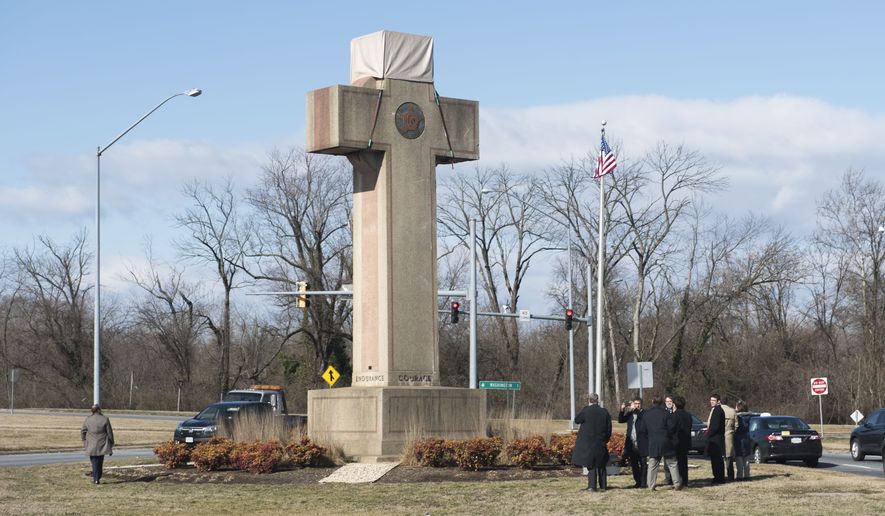Most of the Supreme Court’s justices seemed inclined Wednesday to leave a 40-foot cross memorializing soldiers killed in World War I intact, but they struggled with where to draw the lines on other public displays of religious symbols.
The nearly 100-year-old Latin cross, which stands at a major intersection in Bladensburg, Maryland, has become the focal point of a major battle over the First Amendment, testing how much the passage of time and status as a war memorial can protect it from attempts to tear it down.
“These are Christian symbols,” Monica Miller, a lawyer for the American Humanist Association, told the high court. The group has asked that the memorial be moved or, at the least, be altered so it’s not purely Christian.
The justices, though, wondered what other memorials might have to go if the Peace Cross is deemed unconstitutional. Other cross monuments in Arlington National Cemetery, as well as ones in town squares and historic battlefields, could be on the chopping block, the cross’s defenders said.
“History counts,” said Justice Stephen G. Breyer. “This is a tough area.”
The Peace Cross was erected in 1925 in an effort led by mothers whose sons died in World War I.
SEE ALSO: Supreme Court ‘Peace Cross’ case tackles religious freedom debate
They chose the cross because it was the same symbol that sat atop the graves of their children buried in the war cemeteries in France.
Justice Neil M. Gorsuch wondered whether the law has tilted too far in favor of those who take offense.
“There aren’t many places in the law where we allow someone to make a federal case out of their offensiveness about a symbol being too loud for them,” Justice Gorsuch said.
“We have a Ten Commandments display just above you, which may be too loud for many,” he told Ms. Miller. “Why shouldn’t we apply our normal standing rules and require more than mere offense to make a federal case out of these?”
She said the case against the Peace Cross is about more than a “mere offense.” She said it’s tough to see a 40-foot-tall cross at a major community intersection on government land as anything other than a statement of Christianity.
“It’s not private speech we’re talking about. We’re talking about the government being the speaker and essentially giving you the message as the non-Christian in your community that you are a lesser citizen,” Ms. Miller said.
She said a 40-foot Star of David could also run afoul of the Constitution’s Establishment Clause, which prevents the government from endorsing one faith over another.
Two of the court’s more liberal justices appeared to agree with Ms. Miller.
Justice Ruth Bader Ginsburg said a cross is the “pre-eminent symbol of Christianity,” while Justice Sonia Sotomayor suggested the memorial, already in disrepair, will need to be changed in some way.
“You can move it,” she told Neal Katyal, who represented the American Legion, which helped raise funds to erect the marker.
She suggested transferring the property to a private entity also would be an option.
Mr. Katyal said that’s not likely given the land is at such an important intersection.
He said that while the symbol is a cross, there’s no religious message. The words inscribed on the monument are the names of 49 soldiers who died and the words “valor,” “endurance,” “courage” and “devotion.”
“Not a single word of religious content appears anywhere,” he said.
Justice Samuel A. Alito Jr. said scrapping the cross could also run afoul of the First Amendment, since it could be seen as a statement against religion.
“That may promote a particular world view,” he said.
Justice Gorsuch tried to get the lawyers to urge the court to find a new legal test for religious entanglement challenges.
But both sides demurred, saying the court should wait until the adequate time to take a look at the Lemon Test, which was named after a 1971 case that held that for a practice or an object to be legal, it must have a secular purpose, not advance or inhibit a religion and avoid “excessive government entanglement with religion.”
“It’s been a long time since this court has applied Lemon,” he said. “Is it time for this court to thank Lemon for its services and send it on its way?”
• Alex Swoyer can be reached at aswoyer@washingtontimes.com.




Please read our comment policy before commenting.